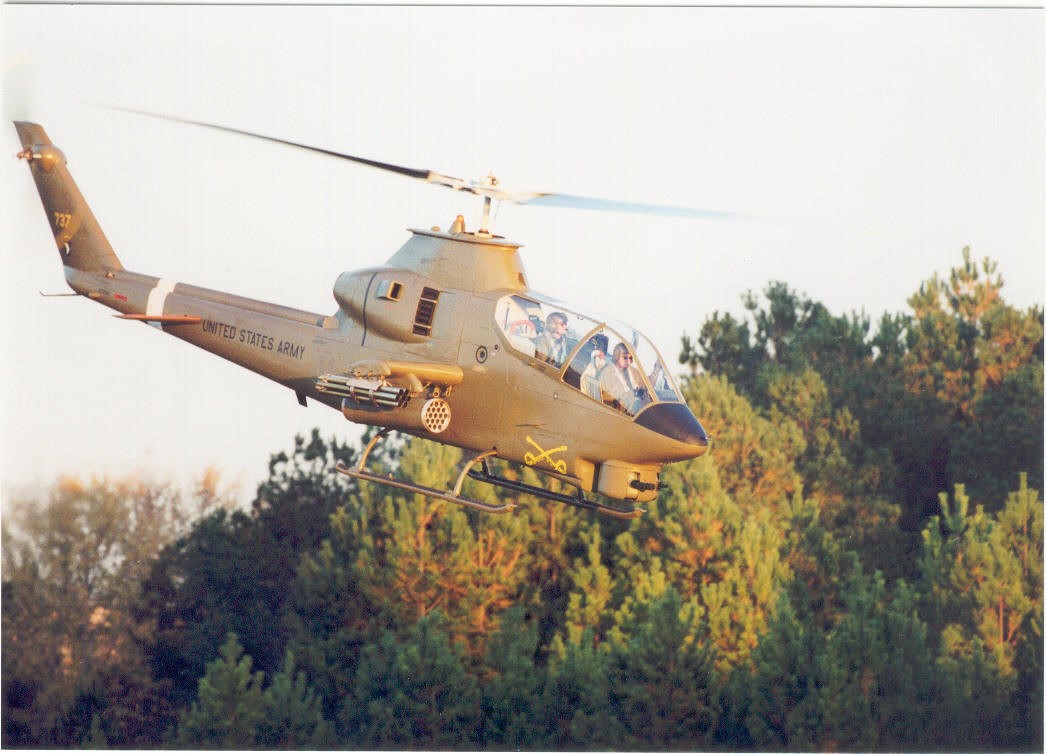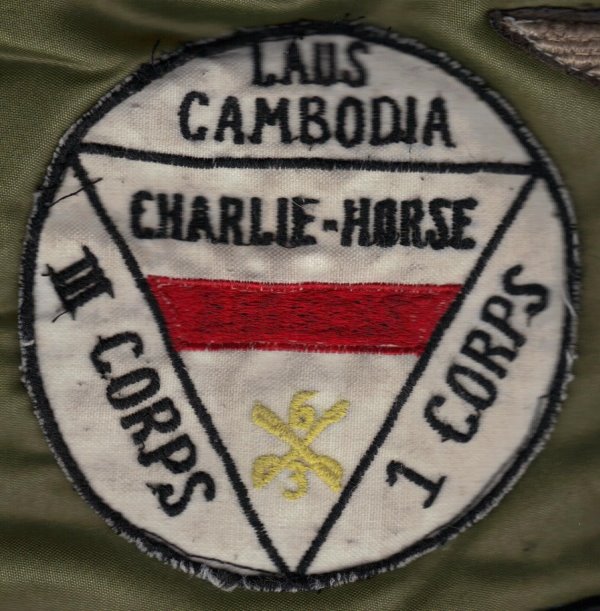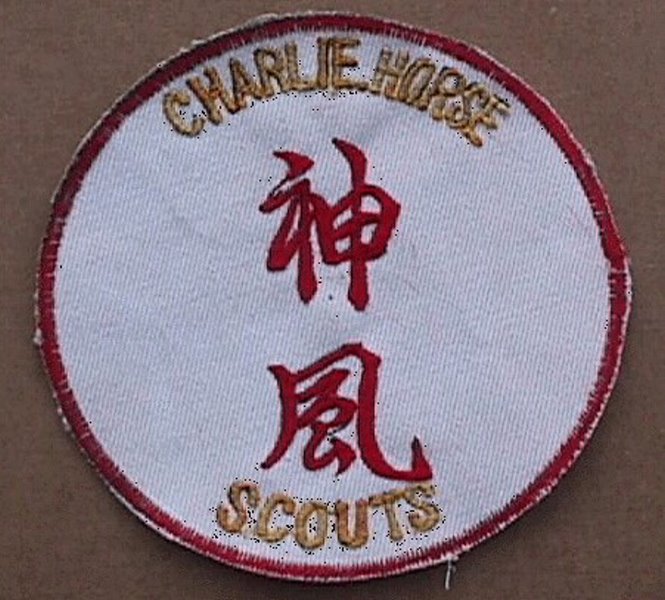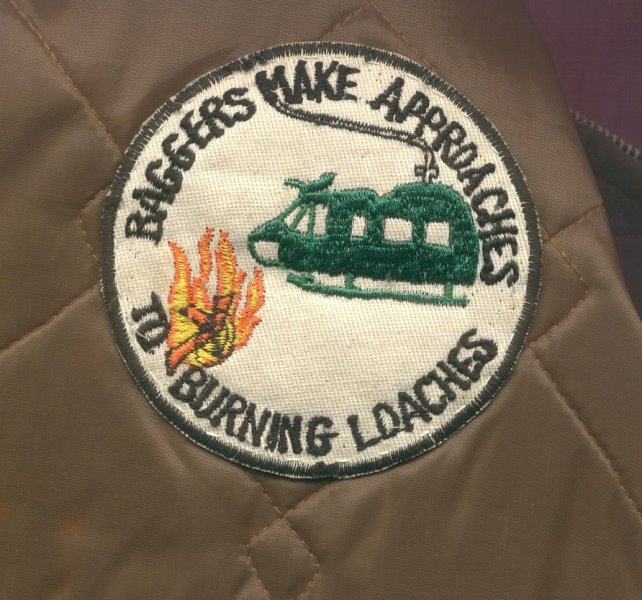How the Unit Performed Its Mission
By John Hiemstra
I flew as a "gunner/co-pilot" which is the front seat pilot which you can clearly see in this photo (not a unit Cobra)

The Cobra was the first helicopter to be designed solely as a gunship hence you don't see any cargo capacity, just two pilots and the weapons systems. The aircraft commander sits in the back and commands the aircraft as well as other aircraft in the mission team.
The co-pilot/gunner sits in the front with a great view forward, almost like you are flying at the front of a stick!
The gunner used a sighting system mounted on a gimbal rail that allowed the gunner to point the gunsight to either side, front and downward to the limits of the gun turret (you see that the lower section of the front of the Cobra.
The turret would point wherever the gunner turned the gunsight, within its limit of movement.
The turret was normally armed with a 7.62 mini gun that fired at a rate of 2000/4000 round per minute depending if you pressed the gun trigger one detent or two detents.
We normally fired the minigun at the 2000 round per minute to conserve ammunition. I think we carried 4000 rounds of 7.62 in the ammo bay which is located under the two pilots.
I used the gunsight to position the minigun in the general area I wanted to shoot at then started firing at the target.
Once the stream of red tracers (one tracer for every 4 ball rounds so there were four bullets you couldn't see) was working its way to the target I would ignore the gunsight and simply adjust the flow of the tracers just like a garden hose on plants!
Easy and very accurate!
The other weapon system we used in the turret (some units used dual miniguns instead of a mix of minigun and grenade launcher) was the 40mm grenade launcher that also was fed from the ammo bay to the gun via a feed line.
This weapon was very desirable, not for its accuracy or deadliness (it could be both actually) but for its suppressive fire role as we broke out of the gun dive and started climbing back up in a steep climbing turn to defeat ground fire as we turn away from the target.
The 40mm fired at a very slow rate compared to the minigun, 700 rounds per minute.
The velocity was quite slow as I could see the individual rounds, in-flight, arc toward the target area like watching a baseball in flight!
Again, once I could see the trajectory of the grenade stream I would adjust the firing angle to move the "stream" onto the target. But since this weapon had a kill radius of about 15 feet when it exploded (50% chance of killing a person exposed to the explosion) I didn't want to put all the rounds into one area. Instead I would spread the stream out over a broad area to be a bigger threat to enemy troops on the ground trying to fire at us as we banked and climbed out of the gun run.
So this weapon was used more as a suppressive fire weapon to keep the enemy gunner's heads down instead of trying to accurately fire at us while we were exposed. The weapon fired so slow that I could still have a stream of shells arcing to the ground well after we had climbed back to a safe altitude (1500 ft/AGL).
The gunner’s role was primarily defensive as the weapon systems were short ranged compared to the main weapon systems, the 2.75” 17lb rockets and 20mm cannon which were our long range attack weapons.
The M195 20mm cannon was a modified Vulcan cannon that fired at a much slower rate than the M61A1 cannon that it was based on.
Our rate of fire was 750 rounds per minute with an onboard storage of 950 rounds.
The 20mm cannon shell has an effective kill radius of two meters (approximately 6 feet). It was effective out to 2000 meters (about 6000 feet) which gave us accurate stand-off attack capability that far exceeded what the enemy had to attack us with unless they had the heavy anti-aircraft (AA) weapons (they did in major actions!).
We could accurately shoot into a bunker opening with this weapon!
We fired it in short burst to conserve ammunition. However, because of its small kill radius, it was not an effective anti-personnel weapon.
For this we preferred the rockets we carried.
The 2.75” folding fin rocket with a 17 pound warhead were our most effective assault weapon as it had the explosive power of a 105mm cannon round.
Some Cobra unit’s sole assignment was “airborne artillery” carrying four 19 shot rocket tubes which were used to support infantry units with close and accurate fire support. In our unit, we carried a mix of 19 shot rocket pods on the side opposite the 20mm cannon.
On the cannon side, we used a 7 shot rocket pod (to balance out the weight of the helicopter…the cannon was heavy). The pilot could control the rocket pods individually or mass fire via a controller called the Intervalometer!
The preferred method was individual rocket pod selection with ripple fire as long as the trigger was held down. That conserved fire power.
We used two types of warheads on the rockets: High Explosive (HE) and Flechette (aka “nails”).
A third type, the white phosphorous was typically used to mark targets for attack airplanes but we never worked with them so had no reason to carry this type of warhead.
The 17 pound warhead was used to attack point type of targets such as a vehicle, sampan, bunker, etc.
The Flechette was used primarily to “keep their heads down” as we escorted the scout helicopter out of the contact area after it was fired on by ground troops. We had to be sure there were no friendly troops in the area (we always determined this during the morning mission brief so we would know to expect or not expect friendly troops, American or Vietnamese, in our assigned search area) before firing the Flechette round as it had a large and deadly footprint, covering a football field sized area with a “nail” every square inch, if fired from the correct 1500 yard AGL height.
A red puff of smoke illuminated the point where the warhead fired off in the air beginning the spread of the nails across the ground.
This weapon definitely put a stop to the shooting at the scout as he fled the area.
In our area of operations, we used this weapon a lot to break up the fight and the enemy, being smart, knew that when the Cobras rolled into the gun run after the scout ship popped the red smoke indicating the position he was being fired at from, that he had just a few seconds to find cover before a buzz storm of “nails” landed in his area!
If you were still standing out in the open firing your AK-47 at the scout ship, you were about to absorb a dozen or so “nails” that flat out ruined your day if not your life.
Rockets were tricky to shoot correctly as you had to have the helicopter in “trim” so that the rocket, as it left the tube, would fly straight instead of angling off into the relative wind.
The aircraft commander fired this weapon as he had the gunsight for it and the Intervalometer for controlling the firing sequence.
The gunner/copilot could fire it, from the cyclic mounted firing button, but had no control of the firing sequence.
Also the gunner had no gunsight for the rockets so it was a wild guess as to where to aim.
I can’t recall ever firing the rockets (or cannon) from the front seat.
Rockets were not only deadly to enemy troops, they could be deadly to the unit members who loaded them into the rocket tubes.
This was the job of the armorers of the unit as well as crew members who would help load the rocket tubes to speed up the turnaround to get the Cobra back up on station. The rockets fired via an electrical impulse delivered via a swivel contact point.
You first made sure the battery power was off to the aircraft (battery power was all that was needed to fire the rockets!) then you swung the contact points aside so the tube was open to inserting the rocket.
You could carry two rockets at a time and approach the rocket pod from behind (the safe side since rockets fired forward!) sliding the rockets into position in the tubes.
Once you had all the tubes filled in the pod, you would swing the contact point over the firing contact of the rocket. Now it was ready to fire, with power applied and the firing button pulled!
The folding fin rocket immediately sprung the fins out as it left the tube so the rocket would start spinning to stabilize in-flight.
Now here is a sad story; an armorer (of another Cobra unit on our base at Camp Evans) approached the front of the rocket tube carrying rockets to load the tubes as another crew member was loading rockets from the rear. Either the power (battery) or static electricity fired the rocket as the contact point was swung into position launching the rocket forward into the armorer who was in front of the pod. The rocket went right through the man slicing him in half as the fins sprung outward into position. He was killed not by enemy action but an act of carelessness on his part (for approaching the pod from the front) and the accidental ignition of the rocket motor.
His name is on the Vietnam Memorial Wall and the family likely never knew he was killed in this manner.
It surely put the fear of God into us, on the base, about properly handling of the rocket loading process.



A mission team, for our Cavalry unit, consisted of a Huey troop carrying helicopter, two Cobras and a scout helicopter.
We nicknamed the Huey the "Bagger" as their job was to rush into the crash site if one of the team members got shot down or crashed from mechanical failure to recover the living and "bag” (combat humor) up the dead.
They flew the highest of the team, about 2000 ft/AGL staying out of the way of the Cobras which were flying in a circle about 1500 ft/AGL staying over the Scout who was flying BELOW the treetops at low speed (often hovering to use their rotor wash to push away camouflage from a bunker).
They also carried an infantry fire team (seven soldiers as I recall) who could jump out to help with the recovery and provide ground support for the survivors if they were engaged in a ground battle at the crash site. It took a lot of courage and determination for the Huey crew to rush into the crash site if the enemy was trying to get to the survivors too!
Two Cobra were used in a “Red Team” (a Pink team was a single Cobra used in relatively safe areas such as the base perimeter) to provide mutual fire support. This means as one Cobra was pulling up from a gun run; the second Cobra began their gun run thus effectively keeping constant fire on the threat. Both Cobras would fly at the same altitude 180 degree opposite each other to be effective with this defensive gun pattern. One Cobra was assigned to be the primary Cobra for initiating the attack run to support the scout as they attempted to flee the enemy fire.
The gunner/co-pilot of primary Cobra was in constant radio contact with the scout helicopter pilot every 30 seconds or less to assure there was good radio contact with the scout pilot. It could be as simple as “Roger 19” (abbreviated scout call sign), or “repeat the last message”.
If contact was lost the scout had to come back up to altitude for safety or it could be the result of enemy fire that had shot out the radio!
In this case we would see the scout heading off in a direction to escape the attack and spot the area of the attack from the red smoke they dropped as they left the contact area. In this case we would issue escape instructions in case they could still hear but not talk.
It was also the responsibility of the primary gunner/co-pilot to direct the scout out of the contact area, in coordination with the aircraft commander, AND start placing effective minigun or 40mm rounds in the target area (the red smoke the scout crew would drop at the moment they were fired on). It was a very busy few moments for the gunner/co-pilot as this multitasking took place to protect the scout.
The primary Cobra crew HAD TO KEEP THE SCOUT in constant visual contact.
If contact was lost the scout had to be brought back up to a safe altitude to re-acquire visual contact.
This was akin to fumbling the football at the kickoff…very embarrassing but a necessary procedure.
I can recall one incident (worked out okay thankfully) where the scout screamed “taking fire…taking fire” and both I and the aircraft commander had lost visual contact with the scout at the same time just before the shooting started. You can’t imagine a more gut wrenching moment than to realize the scout you are protecting isn’t getting the protection they need at a critical moment. All I could do was tell the scout to head east (toward a safer area I hoped) but we couldn’t fire since we couldn’t observe where the scout was.
Scout ships are camouflaged and quite difficult to see both from the ground and from the air!
I think after this incident we started painting one of the scout main rotor blades with white paint on top so we could see it easier from our altitude. It worked well but you had to look off to the side every few seconds to prevent getting dizzy from watching the corkscrew pattern of the white rotor blade.
The secondary Cobra gunner/co-pilot was responsible for recording the intelligence information the scout was reporting, like a court reporter. We learned to use short hand and symbols to quickly record the information, using a black grease pencil, on the Plexiglas canopy.
This information would then be called into operations, once we were at a safe altitude (1500 AGL or higher).
The information we collected would be used by the commanding general of I Corp to keep tabs on enemy activity such as troop build ups.
We would scrub off the grease paint upon landing (our crew chiefs would come out with Plexiglas cleaner to do this task for us so we would be ready to repeat the process after refueling and re-arming, if we had expended ammunition on that mission segment.
Normally the secondary Cobra also tried to keep the scout in sight and maintain position in the orbit
(this was the function of the secondary Cobra as the primary Cobra was focused solely on maintain visual contact with the scout and awareness of where to send the scout if he was fired on).
The secondary Cobra almost always was the second Cobra to enter a gun run to support the climb out of the primary Cobra but in some cases, the primary Cobra would order the secondary Cobra to initiate the first gun run simply because they were in a better position, in the orbit, to support the escaping scout.
You had to be on your toes all the time no matter which position you were flying on that mission.
The primary Cobra always was the mission commander (coach if you want to think of it in sports language).
The scout pilot was the core of the mission.
Without him, we didn’t have the ability to collect intelligence and report it to the general commanding our area of operations!
These guys were always volunteers for a six month tour of duty…if you made it that long without being seriously wounded or killed.
How would you feel about volunteering for a job with those kinds of odds? I salute the ones who did it.
I did a trial scout run with WO1 Bill “Hal” Halevy at the end of July 1971
(I had been in unit two months by that time and was experienced as a team member flying as a Cobra gunner/copilot) in which I got my orientation to scout work…and conviction that being a scout pilot was not for me!
The scout pilot flew at altitude with the rest of the mission team until we got to the assigned search area for that mission.
Once there the scout would rapidly descent, changing altitude, heading and airspeed all at the same time to throw off the aim of any potential enemy gunner looking to get his HERO award for shooting down a helicopter, to his working altitude (tree top or below tree top if spacing allowed between trees allowed for it) to begin his search for signs of enemy activity. He would report things like “day old camp fire”, ” clothes hanging on a line” “ heavy foot traffic on a muddy trail (lots of rain in Vietnam…if you saw footprints they were usually fresh or the rain would have washed them out)”, “Nipa hut” (bamboo shelter)”, “bunker”, “foxholes”.
Of course the dreaded radio call was “taking fire…TAKING FIRE!” followed by a general head count such as three troops or a platoon of troops AND the direction he was heading to break contact with the enemy troops.
The non-flying pilot (usually only the scout pilot and doorgunner/crewchief flew a scout helicopter mission to reduce weight and give more available power for maneuvering) or the doorgunner were tasked to release a red smoke grenade upon contact (gunfire) being initiated irregardless of who started shooting first (it was usually the enemy who shot first).
The smoke grenade was held outside the helicopter with the pin pulled so that the person holding the grenade would automatically drop it if they were killed instantly in the initial gunfire. The contact was over in a few seconds as the scout was either shot down or successfully escaped the contact point.
I remember Hal briefing me on my role as the “guest co-pilot” (I did get to fly the OH-6 that flight in a safe area…it was sporty!) that I was to shoot anyone that appeared on my side of the helicopter (we were pre-mission briefed there were no friendlies in our assigned search area) as they would be enemy! I was also to keep the red smoke grenade OUTSIDE the helicopter with the pin pulled, as he would personally shoot me, if I dropped the grenade inside the helicopter, while we were flying below the treetops, and we survived my error dropping the grenade inside the helicopter!
Being at 10 feet above the ground, maneuvering hard to escape gunfire, with red smoke filling the cockpit, would almost certainly be fatal!
During my time with D Troop, 3rd Squadron, Fifth Cavalry (D 3/5 Cav May – December 1971) we lost a number of scout pilots and crew chiefs either to serious wounds or killed outright during the initial enemy contact. You can read, in my diary, my eyewitness account of Capt Gronberg (scout pilot) and his co-pilot being killed instantly while passing over a bunker for a second (or third) attempt to toss a grenade into an enemy bunker. They were hit by a Rocket Propelled Grenade (RPG) which was a very lucky shot.
The RPG is not designed to shoot down helicopters (but Gronberg was moving slowly to assist the crew chief with his attempt to throw a grenade in the bunker opening)! The crew chief survived but was badly crippled for the rest of his life.
In the same time frame, I can’t recall a single Cobra pilot being injured or killed in our unit.
We did lose a “bagger” helicopter and the entire crew to what we now believe was an early use of the Strella ground to air anti-aircraft missile (SAM) in August of 1971 near the DMZ (border with North Vietnam).
This missile was introduced, in heavy numbers, with the major tank assisted NVA assault into South Vietnam in what was called the April 1972 invasion (I returned home just two weeks before the invasion).
Helicopters had to quit flying at the “safe” altitude of 1500ft AGL (safe from light automatic weapons like the AK-47) and drop down to ground level (below treetops when possible) to avoid the heat seeking SAM missiles which needed a few seconds to lock onto a helicopter engine exhaust signature to get a good tracking angle.
Usually, at ground level, you would be safely past a SAM operator before he could get a good “lock” signal to launch the missile.
I saw a video of a SAM launch on a helicopter flying at 1500 ft AGL.
By the time you see it launch, if you do see it, all you can do is say “Oh God!” and die.
That was our unit mission. Usually it was a fairly safe mission, but at special times, like the Lam Son 719 invasion into Laos, we took heavy casualties. I was a unit replacement to one of the pilot losses suffered, in Lam Son 719, prior to my arrival in the unit.
Diary Web Page 1